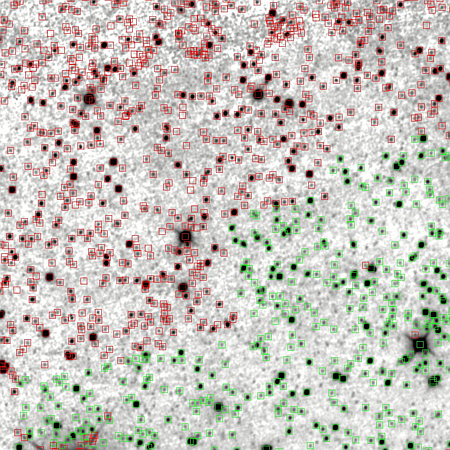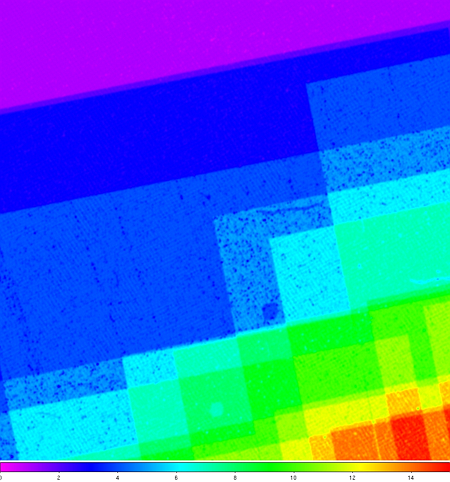


II. The WISE All-Sky Data Products
4. Ancillary Products
a. Reject Table
The WISE All-Sky Reject Table contains 283,887,651
detections that were made on the Atlas Images during
Multiframe Pipeline processing that were not
included in the All-Sky Release Source Catalog
because they did not satisfy the Catalog selection quality criteria described
in V.3. These "source" extractions were rejected
from the Catalog because:
- they have flux signal-to-noise ratios <5 in all bands,
- they are believed to be spurious detections of image artifacts caused
by bright sources, including Mars, Jupiter or Saturn,
- they were detected in an area with less than five
Single-exposure image depth-of-coverage, or
- they are redundant detections of sources in Tile overlap
regions for which an alternate detection was selected for inclusion in
the Source Catalog.
WISE Multiframe Pipeline processing
generated a Working Database of all detections on the
Atlas Images from which both the Source Catalog and Reject Table are drawn.
Therefore, the source detection and extraction algorithms are the same
for both and are described in IV.4.
Directions for accessing the Reject Table are given in
I.3.
Users are strongly encouraged to read the
Cautionary Notes before using the Reject
Table.
The format of the Reject Table is the same as that for the
All-Sky Source Catalog and is described in
II.2.a.
ii. Using the Reject Table
As a rule of thumb, you should assume that
every entry in the Reject Table is spurious until you have verified
its reliability by visually examining its position on the
Atlas Images.
The Reject Table is not a well-vetted list of reliable mid-infrared
source detections. As the name implies, the majority of entries in the
Reject Table are likely spurious detections of low SNR noise events, image
artifacts, or transient pixel events such as cosmic rays.
However, the Reject Table does contain some low SNR extractions of real
sources, as well as reliable measurement of bright sources that
may have been omitted from the Source Catalog because of
overly conservative artifact flagging in some regions,
or because they fall in areas with low Single-exposure depth-of-coverage.
Used with caution, the Reject Table can be a useful database that
augments the Source Catalog, particularly when following-up
sources that appear on the Atlas Images but are not found in the
Catalog.
The following are some examples where the Reject Table entries may
be useful.
- Low SNR sources - Pipeline extracted positions and fluxes
for faint sources. SNR threshold
for Catalog selection required SNR>5 in at least band.
As discussed in VI.6, the reliability of extractions
down to the Multiframe Pipeline detection
limit (SNR>3.5) is estimated to be >99%
in unconfused regions. The reliability is lower in higher source
density and complex regions, but still better than approximately
80%. Because of the multi-band nature of source extraction
used in the WSDS, source reliability is driven strongly by
the band with the highest SNR, and this is most often (but not always) W1.
Therefore, Reject Table entries that have
w1snr<5 and
are not otherwise flagged as contaminated by a bright source image artifact
(cc_flags='0000') or
in a low coverage region (w1m>4)
stand a reasonable chance of being reliable detection.
- Overly conservative artifact flagging - As described in
IV.4.g, flagging source
extractions in Multiframe Pipeline processing was a complex
procedure that could not be perfect in all circumstances. In particular,
three areas in which the flagging was known to be overly conservative
and could result in the incorrect exclusions of sources from the
Catalog were in very high source density regions, near the Ecliptic
poles, and in the vicinity of extremely bright stars.
- In very high source density regions in the Galactic plane, the
contrast of image artifacts is lower with respect to the
the elevated background emission levels. The background-dependence was
compensated by background
scaling of the predicted diffraction spike length in the
artifact identification procedure. The scaling was not perfect
in regions with the highest background levels, and could result
in overflagging extractions as spurious detections of artifacts.
You can check the reliability of Reject Table entries in high
source density and high background regions by examining them
on the Atlas Images.
- Near the Ecliptic poles, the rotation of the WISE
scan angle and the
pixel outlier rejection used
in the image coaddition procedure resulted in diffraction spikes
from bright stars would appear significantly shorter than from
stars of the same brightness at lower ecliptic latitudes. The
effects of scan rotation were compensated by
ecliptic latitude-dependent
scaling in the artifact identification subsystem. However, this
scaling was not perfect and resulted in a net overflagging of extractions
as spurious detections of diffraction spike artifacts near the Ecliptic pole
(e.g. see Figure 21 in IV.4.g.i).
Therefore, Reject Table entries that are within a few degrees of
the Ecliptic poles and are flagged as spurious detections of
diffraction spikes (cc_flags matches '*D*')
may be real source detections. Verify this by examining the source
on the Atlas Images.
- The artifact identification and flagging
geometric model used in the WSDS pipelines was based
on the position and brightness of the "parent" source that produced the
artifact. Sources brighter than approximately 2.0, 1.5, -3.0 and -4.0 mag
in W1, W2, W3 and W4, respectively, were heavily saturated and
were not reliably extracted.
The artifact identification procedure filled in missing bright source
detections using a prior table of very bright sources with positions
and brightnesses estimated from other sources such as IRAS and 2MASS
(see IV.4.g). The accuracy of artifact
identification depended strongly on the accuracy of the parent source
parameter knowledge, so extractions near the augmented bright sources
could be either over- or under-flagging depending how well the
predicted position and brightness matched the true values for
the sources at the time of the WISE observations. Therefore, Reject
Table entries in the vicinity of very bright sources may be
reliable. Verify this by examining the source on the Atlas Image.
- Low depth-of-coverage regions - The All-Sky Catalog
source selection criteria required WDB
extractions to have been made in areas for which there were
five or more Single-exposure images available for the source measurement
because pixel outlier rejection
will effectively suppress spurious detections of single frame events
such as cosmic rays, satellite trails, and noise excursions.
As illustrated in Figures 1 and 2, the Reject Table contains
reliable detections of sources in regions with depth-of-coverage
too low to be included in the Catalog.
The Reject table will also contain spurious detection of single
frame events, though, so care must be taken to discriminate between
real and false detections in these regions. Some artifacts, such as
detections of satellite trails, are easy to identify visually on the
Atlas Images by their morphology. However,
spurious detections from some cosmic ray strikes and single-pixel
noise events can mimic real sources on the Atlas Images because
of the smoothing effects of the
PSF-interpolation in the coaddition
procedure. The most reliable entries in the Reject Table
in regions where the depth-of-coverage
w?m<5 in all bands, and
where the source appears real on the Atlas Image, will have been detected
on all of the available Single-exposure images, so the ratios
w?nm/w?m
will be close to unity. The corollary to this is that the smaller the number
of Single-exposure images that were available for the Reject Table extraction,
w?m, the less confident you should be
in the reliability.
 |
 |
| Figure 1 - A 1000x1000 arcsec section of the southwest corner of
W1 Atlas Image 1088p696p_ab41. Green boxes mark the positions of
All-Sky Source Catalog entries and red box mark the positions of
entries in the Reject Table. Many of the Reject Table entries in
this the upper left half of this image are reliable source detections that
fall in low depth-of-coverage areas. |
Figure 2 - The 1000x1000 arcsec section of the southwest corner of
the W1 depth-of-coverage image for Atlas Tile 1088p696p_ab41. The All-Sky
Catalog source selection criteria required a minimum depth-of-coverage of
five or more Single-exposure images on which a source could be measured.
|
Last update: 2012 February 24







